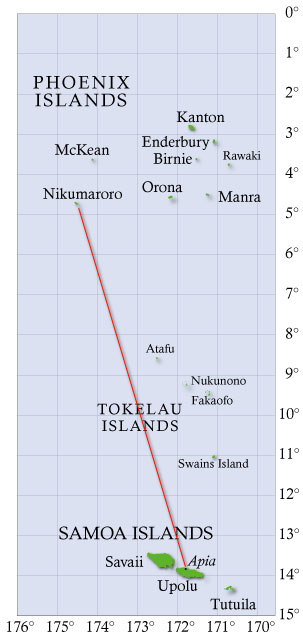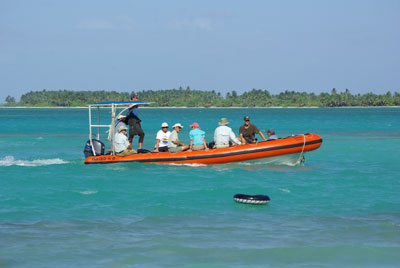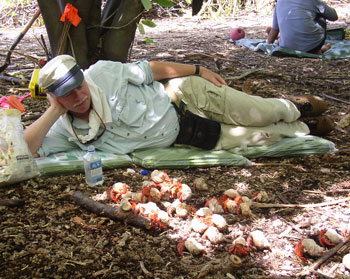All Sponsor Team Member
slots have been filled. Thanks to all!
Sponsor Team Members have been an essential and successful
part of TIGHAR’s many expeditions to Nikumaroro. Funding for the Niku
VI expeditions in May/June 2010 will come, in part, from a limited number
of Sponsor Team Members.
What is a Sponsor Team Member?
Sponsor Team Members participate in
the expedition as members of the TIGHAR archaeological team in consideration
of a $50,000 contribution to help fund the project. The contribution covers
all expenses Los Angeles to Los Angeles.
Is the $50,000 tax deductible?
TIGHAR
is a 501(c)(3) public charity. If you are a U.S. citizen your contribution
is tax deductible to the full extent of the law minus an amount equal to
your pro rata share of the actual cost of the trip.
How long would I be away?
The entire Niku VI expedition will run from May 18 to June 14, 2010 but
you don’t
have to be away for that long. Halfway through the trip there will be an
opportunity for team members to leave or join the expedition so you can
participate in the first segment (May 18 to 31) or the second segment (June
1 to 14) or participate in the entire expedition. Your choice, but the
sponsorship requirement is the same.
 What would it be like? What would it be like?
You’d fly from Los Angeles to Apia, Samoa where
you would board the expedition ship Nai’a for the two and half day voyage to
Nikumaroro (“Niku” for short). During the expedition you would share a cabin
aboard Nai’a with another team member – perhaps another Sponsor Team Member,
perhaps a regular Project Team Member. Once you’re on the team, you’re
on the team. No special privileges. All team members sign liability releases,
model releases (giving TIGHAR permission to use your photograph), and assignments.
(There is no souvenir hunting. Anything we find is held in trust by TIGHAR
for the Republic of Kiribati which owns Nikumaroro.) Nikumaroro is part
of the Phoenix Islands Protected Area (PIPA), the world’s largest marine
preserve. TIGHAR expeditions require the permission of the PIPA administrators
and a Republic of Kiribati representative accompanies us to verify that
we follow the protocols and precautions necessary to preserve the pristine
beauty of this incredible island.
The TIGHAR approach to expeditions.
In twenty-five
years of conducting aviation archaeological operations all over the world
(this will be our tenth trip to Niku), we’ve developed a style that is
best expressed in a few bumper-sticker style aphorisms.
- We take the work
seriously, but not ourselves.
- Leave your ego on the dock.
- The team functions as a family. We look out for each other.
- We don’t take unnecessary chances. It’s not worth
hurting live people to look for dead ones.
- We’re out there to get the
work done, not have an adventure. Adventure is what happens when things
go wrong. There’s always plenty of adventure.
A typical day at Niku
Breakfast at 0600
We live aboard the ship and commute to work ashore. Nai’a is not a big ship
but she’s a comfortable ship. Each cabin is individually air-conditioned
and has a private head (toilet) and shower. We dine together in the main
salon and the food is first class.
 First skiff ashore at 0730 First skiff ashore at 0730
Nai’a uses
hard-bottomed inflatables known, coincidentally, as Naiads. Boarding
and disembarking the skiffs from the ship’s aft dive platform in
a choppy sea requires timing, core strength, and agility. A misstep can
mean getting crushed between the skiff and the hull. The Black Tips (reef
sharks) are always on hand to help should anyone fall overboard.
We land on the island via a narrow
channel that was blasted through the fringing reef. Climbing in and out of
the skiff and transferring bulky gear on slippery footing while standing
in the surf is not for the clumsy of body or the faint of heart.
Getting
to the archaeological site.
Once ashore, we carry the gear, water and food
we’ll need for the day’s work along a trail
through the coconut jungle to the lagoon shore where we load aboard
another skiff for the twenty-minute boat ride down the lagoon to the
Seven Site, the area at the remote southeast end of the atoll we believe
to be the place where the castaway campsite was discovered in 1940.
Work at the Seven Site
Although a relatively pleasant open forest in 1937, the site is now
overgrown with scaevola, dense tropical vegetation that must be cleared
before the ground can be archaeologically searched for features and
artifacts. Clearing operations are complicated by the need to avoid
dragging cut brush over ground we don’t want to disturb.
 Cutting, carrying, and piling the scaevola is hard physical work.
Once an area has been cleared, the exposed surface is a thin layer
of dead leaves and other detritus on a base of “coral rubble,” roughly finger-sized chunks
of loose coral. Searching for artifacts is hands and knees work, carefully
removing the leaf layer and using a trowel to scrape away the coral rubble
down to a predetermined level. The removed material is then put through a ¼ inch
screen to reveal any objects that were missed during troweling. All of this
is done in temperatures that regularly exceed 110°F. (Indiana Jones
leather jackets not recommended.) The work requires constant vigilance
and attention to detail in conditions that are, frankly, brutal. We
take breaks as needed but if you lie still for too long the crabs come
to check on you. Cutting, carrying, and piling the scaevola is hard physical work.
Once an area has been cleared, the exposed surface is a thin layer
of dead leaves and other detritus on a base of “coral rubble,” roughly finger-sized chunks
of loose coral. Searching for artifacts is hands and knees work, carefully
removing the leaf layer and using a trowel to scrape away the coral rubble
down to a predetermined level. The removed material is then put through a ¼ inch
screen to reveal any objects that were missed during troweling. All of this
is done in temperatures that regularly exceed 110°F. (Indiana Jones
leather jackets not recommended.) The work requires constant vigilance
and attention to detail in conditions that are, frankly, brutal. We
take breaks as needed but if you lie still for too long the crabs come
to check on you.
Late in
the afternoon we secure the site, travel back up the lagoon, cross
to the ocean side, board the skiff and are usually back aboard Nai’a by about 17:30. Showers, writing up field notes, uploading digital
photos to a central archive, and dinner are followed by a team meeting
during which we discuss the events of the day and make any needed adjustments
to the plan for the next day.
How
to apply to become a Sponsor Team Member
All sponsor team member slots for Niku VI have been filled. Please get
in touch with Ric Gillespie for information about participation and sponsorship
in other ways.
|







